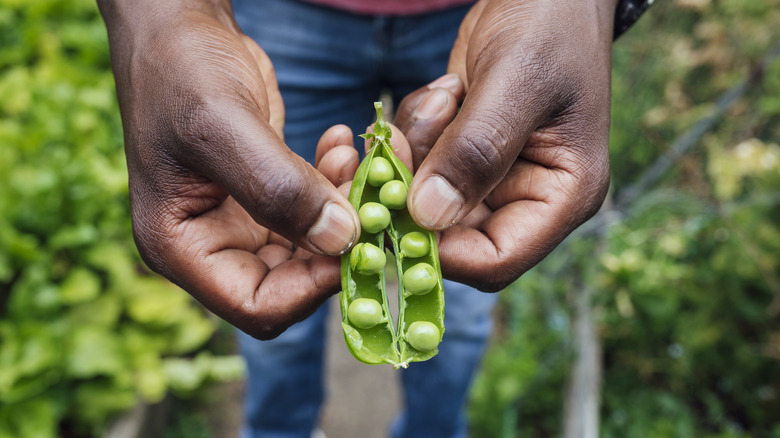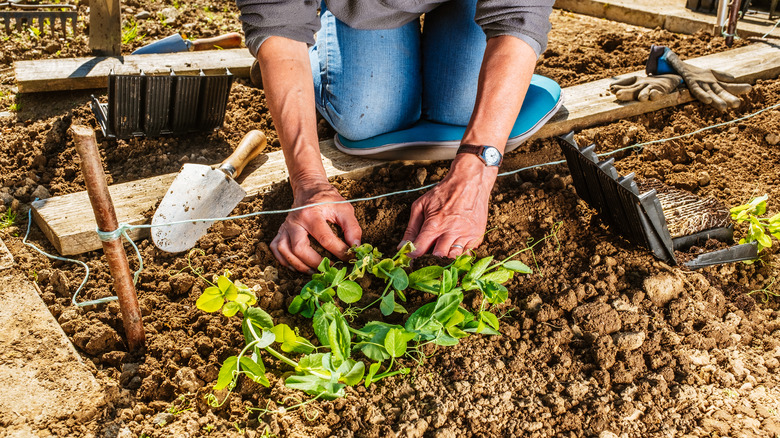The Easy DIY Pea Trellis You Can Make On A Budget
If this is your first year growing peas, it's important to know that your plants will benefit from a trellis. This is a vertical framework that's meant to give climbing plants ideal growing room, more sunlight, and improved air circulation. Although not all peas need trellises to grow, having some support to hold their vines upright will make a significant impact on all types of peas' growth cycle. Further, it's always best to place your trellis down before getting your peas in the ground, so you'll need to build this piece first. One TikTok user, @makinghomematter, has the perfect tips for getting your pea trellis done with items you may already have on hand, making it budget-friendly. To create the trellis, you'll build the frame, attach a string, and plant your peas around it.
Peas typically come in two styles: bush and climbing. Bush peas typically grow to about 3 feet tall, while climbing peas can reach about 8 feet in height, and both types will love a trellis. Be sure to plant your peas in early spring, as they prefer a cool, wet environment with a soil temperature that's above 45 degrees Fahrenheit. They'll typically need full sun for at least six hours a day and extremely limited access to wind. Also, be sure to test the pH balance of your soil if possible. Ensure it's well drained and stays between 6.0 and 7.5 to keep your peas healthy.
Building your pea trellis
You'll need 1x2-inch pieces of wood, wood screws, nails, a hammer, drill, and garden twine. Cut the wood into four longer pieces with 45-degree angles on one side and connect two of each piece with the drill and screws to create identical triangles for the sides. Then, cut three more pieces of wood and attach them horizontally between the triangles — one on top and two on the bottom. Next, cover your trellis with your preferred stain. The TikToker went for a dark wood stain, but there are plenty of unique wood finishes to use around your house.
Next, you'll want to hammer in nails on the perimeter of the trellis. Be sure to space each one about 8 centimeters apart, and leave a bit of the nail head out for wrapping your twine. Take your twine and wrap it up and down. Do this until you've hit every nail, then continue the same process horizontally. Be sure to tie the twine tightly at the end so it doesn't unravel. Twine is an amazing option here because peas have 1-inch thick tendrils that only wrap around materials that are a quarter inch wide or less. If you're not a fan of twine (or just don't have any), string or wire mesh works here, too. Place your trellis in your garden, then plant your peas. Rule of thumb: plant your seedlings on the sides of the trellis for the best outcome.
Pairing other plants with your peas
Consider adding a few companion plants that will totally flourish beside your luscious peas. Great options are turnips, tomatoes, radishes, and spinach because they can naturally exchange nutrients to benefit the other's growth cycle. For example, peas release nitrogen into the soil, making it an ideal space for many plants that need lots of this nutrient. Further, now that your new trellis is built, repurposing it for other plants is a sustainable option that will aid your green thumb. Some notable plants to consider are beans, melons, and spinach. Cucumbers also thrive with a trellis. A great idea if you don't want a busy garden is to grow your peas and then plant your cucumbers in the same soil, as peas can ready the soil for this next crop. Keep in mind that when you grow cucumbers on a trellis, it may be best to add another trellis to ensure it has plenty of space to vine all over the place.
Your trellis can also serve as shade for plants that aren't fans of full sun. In the TikTok video mentioned earlier, the user places their lettuce plants underneath the middle of the trellis to get away from the direct sun. Broccoli and cilantro are other options that could benefit from being planted underneath the trellis. Beyond blocking them from extended sun exposure, the trellis can also help your seedlings stand upright.

